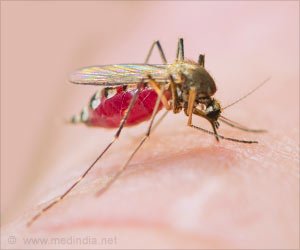Combat Malaria, Dengue & Zika With Insecticide Paint

VESTA insecticide paint, applied to homes in vulnerable neighborhoods, kills Aedes aegypti mosquitos by 98% for at least a year, offering a potential solution for controlling vector-borne diseases such as malaria, dengue, and Zika infections.
These results have been published in Frontiers in Tropical Diseases (1✔ ✔Trusted Source
Insecticide paints: a new community strategy for controlling dengue and zika mosquito vectors in Cabo Verde
).
Painting Away Mosquitoes: Long-lasting Insecticide Paint Shows Promise
Malaria and other illnesses caused by parasites, viruses, and bacteria transmitted by organisms that spread infectious pathogens account for more than 17% of all infectious diseases worldwide. These vector-borne diseases, typically transmitted by insects like mosquitoes, flies, and ticks, disproportionally affect the poorest populations in tropical and subtropical regions.
In Cabo Verde, an island nation off West Africa, vector-borne disease has been prevalent for centuries, in part due to the island’s geographical location and climate. Now, researchers in Cabo Verde and Spain set out to test the efficacy of three insecticide paint formulations to reinforce the existing national program to minimize disease outbreaks.
“Here we show that VESTA insecticide paint is effective at killing Aedes aegypti, the yellow fever mosquito, in the city of Praia for at least one year,” said lead author Dr. Lara Ferrero Gómez, who coordinates a research group on tropical diseases at the Jean Piaget University of Cabo Verde. “We also found it has good acceptance in the population, with 98% confirming the decrease in mosquitoes in their residences after paint application.”
In a large-scale field trial, trained volunteers painted 228 houses in two Praia neighborhoods particularly vulnerable to diseases transmitted by mosquitoes. This is due to insufficient drainage which leads to flooding in the rainy season and poor wastewater management. Additionally, many residences in Cabo Verde store water due to insufficient and disrupted water supply, and water storage is often unsafe.
After one, three, six, and 12 months, WHO cone bioassays were conducted at two randomly selected houses in each neighborhood. “Bioassays record the mortality of A. aegypti mosquitoes after exposing them for half an hour to the insecticidal paint. This allows us to directly evaluate the effectiveness of the insecticidal paint,” Ferrero Gómez explained.
Did You Know?
Almost half of the world’s population, about 4 billion people, live in areas with a risk of dengue. Each year, up to 400 million people get infected with dengue. Approximately 100 million people get sick from infection, and 40,000 die from severe dengue.
All three insecticide paint mixtures lead to complete mortality of A. aegypti mosquitoes one month after the houses were painted. Three months after painting, all formulations still exceeded the WHO efficiency threshold, which lies at 80%. At month six, two formulations fell below this threshold. The VESTA formulation, however, also met WHO requirements at months six and 12. “The paint works by releasing very small quantities of insecticide over a long period, which makes it more sustainable and eco-friendlier,” Ferrero Gómez pointed out.
Advertisement
The researchers did not register any serious effects of the paint on residents’ health. Adverse effects reported by a few residents included mild eye or nose irritation (10%) and headache (4%).
At the beginning of the year, Cabo Verde was the third country in Africa to be declared free of Malaria by the WHO. The challenge to stop its reoccurrence, however, remains. The researchers said that insecticidal paint is also a promising strategy to strengthen the prevention and control of malaria cases at a household level since insecticide paint is effective for any type of vector disease transmitted by mosquitos, not just zika and dengue fever.
Advertisement
While the researchers face certain limitations, such as the need to meticulously apply the paint in two layers to ensure it does not lose its effectiveness, the TINTAEDES project is expected to extend to more locations across Praia, which is a hotspot for vector-borne diseases, as well as across all of Cabo Verde.
Reference:
- Insecticide paints: a new community strategy for controlling dengue and zika mosquito vectors in Cabo Verde – (https://www.frontiersin.org/articles/10.3389/fitd.2024.1321687/full)
Source-Eurekalert
Source link
#Combat #Malaria #Dengue #Zika #Insecticide #Paint



